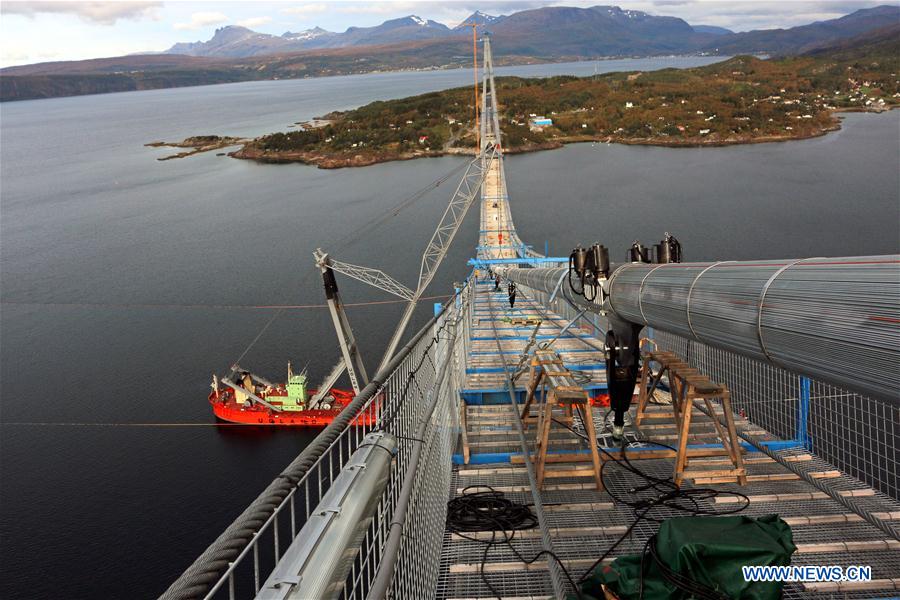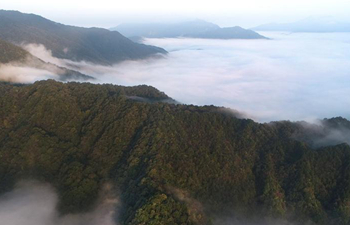
Photo taken on Sept. 15, 2017 shows the Halogaland Bridge is being built by the Sichuan Road and Bridge Group (SRBG) from China over a fjord by the city of Narvik in northern Norway. With a free span of 1,145 meters, the Halogaland Bridge in northern Norway that is being built by a Chinese company will be one of the longest suspension bridges in Europe when it opens for traffic in the summer of 2018. (Xinhua/Yngve Jacobsen)
by Yngve Jacobsen
NARVIK, Norway, Oct. 13 (Xinhua) -- With a free span of 1,145 meters, the Halogaland Bridge in northern Norway that is being built by a Chinese company will be one of the longest suspension bridges in Europe when it opens for traffic in the summer of 2018.
Considered to be a "highly socioeconomically profitable" project, the Halogaland Bridge is located in the High North, 300 km north of the Arctic Circle, and crosses a fjord by the city of Narvik in northern Norway.
The bridge will contribute to a significant shortcut on European route E6, the main north-south road through Norway and the west coast of Sweden.
It is the Sichuan Road and Bridge Group (SRBG) from China that has delivered the steel constructions and is responsible for the mounting. For a year and a half, about 70 Chinese have worked with the bridge.
BIG AND CHALLENGING JOB
The Halogaland Bridge is the fifth largest suspension bridge in Europe and the second largest in Norway. The East Bridge, as part of the Great Belt Fixed Link in Denmark, has Europe's longest main span of 1,625 meters.
For SRBG, the bridge being built in northern Norway is not its record for the longest span. In 2009, the Chinese company finished building the Xihoumen Bridge in Zhejiang, China, with a main span of 1,650 meters.
However, when asked if the Halogaland Bridge is just a small job for SRBG, the Chinese company's project director Lu Wei said it is still a "big and challenging" project.
"No, by no means. Any bridge with a free span over 1,000 meters is considered as 'super bridge' worldwide. So this is a very big and challenging job also for our company," Lu told Xinhua as he stood on a highly elevated catwalk over the construction site.
On this perfect autumn day with a wind of only three to four meters per second, two tugs, the crane ship "The Owl", the cargo ship "Korex 2" and a strong crew were working underneath the temporary hanging work roads between the towers of the bridge.
"This project is really a challenging experience when it comes to bridge construction, also compared to the much larger Xihoumen Bridge that we have built," Lu said. "The Halogaland Bridge has a very special design with cables and structure."
"The SRBG will collect all resources and complete this project according to Norwegian standards," he added.
With the North Atlantic as a close neighbor, weather in these areas could change quickly, which has resulted in a number of days of shutdown in connection with cable pulling and mounting of the bridge sections, Lu said.
INCREDIBLE PRECISION
Because of the size of the project and special requirements of the bridge's concrete and steel, the Norwegian Public Roads Administration (NPRA) was obliged to advertise the main contracts worldwide, not only in the European Union (EU) area.
One assumed that the steel expertise could be difficult to find in Europe alone for a specially designed project of this size. When the tender announcement was published, it attracted international attention due to its complexity.
In 2013, the SRBG from China eventually won the steel contract in a tough competition with the world's leading bridge builders.
The steel contract for SRBG with nominal 755 million kroner (96 million U.S. dollars) includes preproduction of all the parts -- cables and steel boxes and site construction. The production of the steel parts was carried out in four different factories in China and lasted for four years.
The Norwegian road administration's employees who were deployed at these factories to follow the production have stated that the parts were made with incredible precision, so that they could fit together as a construction set.
GOOD COOPERATION
The Norwegian project management said the Chinese company was doing well in the multinational construction site with workers from Iceland, Norway, Sweden, Poland, Switzerland, Turkey, Serbia, Vietnam and China.
"Norwegian and Chinese requirements are different, but the Chinese have proven to be very adaptable. They take a quick grip on new things and we cooperate well," said Hans Jack Arntzen, project manager with the NPRA.
He also said that the Chinese company has a strong focus on the management of health, safety and environment (HSE).
"The steel enterprise, which the Chinese handle with great precision, knowledge and experience, includes heavy crane lifts at high altitudes with not so few risk factors," Arntzen said. "We have not had serious absence injuries, which shows that the Chinese have a strong focus on HSE."
Meanwhile, the Chinese said they could also learn from the high standard of managing health, safety and environment in Norway.
"We have received good help and support from the client from the very first moment and we cooperate well, which is a prerequisite for a good result," Lu said, referring to the NPRA.
"Norway has a high standard of HSE, which contributes to a safe working environment for our workers. We learn from this and intend to transfer it to China," he said.















